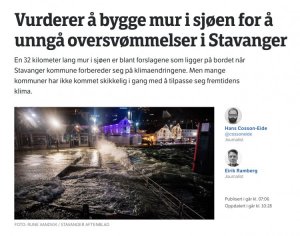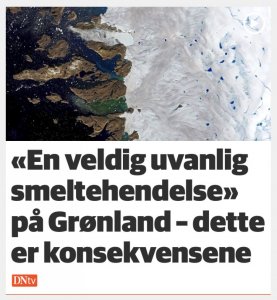G
Gjestemedlem
Gjest
The Bigotry of Environmental Pessimism
https://quillette.com/2019/08/15/the-bigotry-of-environmental-pessimism/
Democratic Presidential candidates and the New York Times rightly condemned the use of inflammatory words like “invasion” by President Donald Trump and Fox News hosts to describe the desperate people coming from Latin America to seek a better life in the U.S. Such language is irresponsible and may very well have contributed to the motivation of a man suspected to have killed 13 Americans, eight Mexicans, and one German in El Paso last week. In a manifesto he posted online before the attack, the suspect also used the word “invasion.”
While they are at it, they should condemn the inflammatory rhetoric used by environmentalists, which also may have contributed to the motivations of the El Paso shooting suspect. The suspect justified his mass shooting of people in a Walmart by arguing that “our lifestyle is destroying the environment of our country.” The suspect writes, “y’all are just too stubborn to change your lifestyle. So the next logical step is to decrease the number of people in America using resources. If we can get rid of enough people, then our way of life can become more sustainable.”
For over 50 years, environmentalists have argued that a significant down-sizing of American living standards is required to prevent environmental catastrophe. They have been attacking the American lifestyle since the 1960s, and Walmart since the 1990s. The El Paso shooting suspect named his manifesto “The Inconvenient Truth,” a title nearly identical to the 2006 documentary about Al Gore’s slideshow on global warming. In it, Gore says: “The truth about the climate crisis is an inconvenient one that means we are going to have to change the way we live our lives.”
Many Democrats and New York Times readers will object that we cannot attribute the El Paso shooting subject’s actions to Gore or to the language he uses. But if that’s true, then we can’t attribute them to Trump and Fox News, either. We can’t have it both ways.
After I made this point on Twitter, some people replied that while the suspect may have had environmental concerns, he acted on his anti-immigrant beliefs. Others said that had he acted on his environmental concerns, he would have shot up ExxonMobil. But such claims demonstrate ignorance of what the shooting suspect wrote, his worldview, and the ways in which it “echoes,” to use the Times’ word, the long history of anti-immigrant, Malthusian environmentalism.
The suspect clearly states that his decision to kill immigrants was, in significant measure, because of their impact on the natural environment. “Of course these migrants and their children have contributed to the problem, but are not the sole cause of it,” he writes. “The American lifestyle affords our citizens an incredible quality of life.”
The El Paso suspect said he was partly inspired by the suspected shooter of Muslim immigrants in New Zealand in March, who also made clear in a manifesto that environmental concerns motivated his anti-immigrant ones. “Why focus on immigration and birth rates when climate change is such a huge issue?” the New Zealand shooting suspect asks. “Because they are the same issue, the environment is being destroyed by overpopulation, we Europeans are one of the groups that are not overpopulating the world.”
It is not surprising that the two manifestos echoed environmentalist ideas. For two centuries, prominent scientists, conservationists, and journalists, have blamed immigrants, the poor, and non-whites for their degradation of the natural environment. Much of what we call “environmentalism” is simply a repackaging of the ideas of 19th-century economist Thomas Malthus. He believed overpopulation of the poor would deplete resources, and that the ethical thing to do was let the poor die of hunger and disease to prevent more hunger and disease in the future. “Instead of recommending cleanliness to the poor, we should encourage contrary habits,” he wrote, “and court the return of the plague.” The British government and media used Malthus’ ideas to justify the policies that led to mass starvation in Ireland from 1845 to 1849.
After the Second World War, leading conservationists embraced Malthus’ view that overpopulation would result in resource depletion. Their concerns were directed at poor non-whites in other countries, particularly India, even though North Americans and Europeans consumed and produced an order of magnitude more resources and pollution. Anti-humanist environmentalism came full bloom in Stanford biologist Paul Ehrlich’s 1968 Sierra Club book, The Population Bomb, which used dehumanizing language similar to that used by today’s anti-immigrant activists. In the opening pages of his book, Ehrlich depicted poor people in India as animals, “screaming…begging…defecating and urinating.”
More recently, environmentalists and scientists concerned about overpopulation tried to get the Sierra Club to oppose immigration from Mexico and other Latin American countries, expressing the concern that, by adopting an American lifestyle, immigrants will use up supposedly scarce natural resources—the same argument used by the El Paso shooting subject—and increase pollution.
Both the El Paso and New Zealand suspects echo the exaggerated rhetoric of environmentalists. “Nothing is conserved,” wrote the New Zealand shooting suspect. “The natural environment is industrialized, pulverized and commoditized.” The El Paso suspect blames “consumer culture” for plastic and electronic waste, and “urban sprawl” for environmental degradation.
The El Paso suspect says environmental destruction was “brilliantly portrayed in the decades old classic The Lorax,” which is a children’s book about a greedy entrepreneur who shortsightedly chops down all of the trees. “Corporations are heading the destruction of our environment by shamelessly overharvesting resources,” he writes. The New Zealand shooting suspect agrees. “Not a thing has been conserved other than corporate profits and the ever increasing wealth of the 1% that exploit the people for their own benefit.”
Both men’s views are highly simplistic. Happily, Malthusian environmentalists, including the two shooting subjects, are wrong about the environment, and have been since Malthus wrongly predicted that too many people would result in famines and resource scarcity. Technology has outpaced increases in population and consumption, so that today humankind faces the prospects of reducing the total amount of our usage of natural resources, including land.
It is simply not the case that “nothing is conserved,” nor that “urban sprawl” is a major problem in comparison to other uses of land. Humans use about half of the ice-free surface of the earth, with just one to three percent of it used for cities. In fact, by increasing the size of cities through industrialization, we have been able to return more of the countryside to nature. Urbanization and industrialization have mostly been good, not bad, for the natural environment. When people move to cities and grow more food on less land, forests grow back and wildlife returns. This has been happening in developed nations for over 100 years, a process that could begin in most poor and developing nations before mid-century. If we encourage the process of ecological modernization, it will happen faster. That means humanistic environmentalists should help poor countries move up the energy ladder, from wood to hydroelectricity and coal to natural gas to uranium.
The “Lorax” view of environmental problems as a consequence of greed has always been wrong and depressing. Environmental problems, from climate change to plastic waste to species extinctions, mostly result from people trying to improve their lives, not from a few greedy corporate fat cats. Around the world, where important natural grasslands and forests are vulnerable, they are usually threatened by people seeking to expand agriculture to produce the food that people need, not to build suburban Walmart stores.
Anti-humanist environmentalists have long exaggerated high birth rates in poor nations, even while condemning the most effective ways to lower them. The New Zealand shooting suspect opens his manifesto by repeating “it’s the birth rates” three times. He later writes, “There is no Green future with never ending population growth, the ideal green world cannot exist in a World of 100 billion 50 billion or even 10 billion people.”
But technology is a far bigger factor in determining humankind’s environmental impacts than fertility rates. Modern agriculture reduces by half the amount of land we need to produce the same amount of food. Nuclear plants require less than one percent of the land that solar and wind farms need to produce the same amount of electricity. With abundant clean nuclear energy, we will never run out of food, because it can be used to desalinate water, produce fertilizers, and even power indoor farms.
Birth rates among wealthier, more industrialized populations are a product of choice, driven mostly through a reduced need of children for farming. Unsurprisingly, the New Zealand suspect cites China as a model. For decades it enforced a draconian “one child” policy when birth rates would have fallen on their own.
Why do the shooting suspects and other pessimists get the environment so wrong? Perhaps because doing so makes them feel better about themselves and their place in society. Environmentalist concern over birth rates has always been disproportionately focused on immigrants, non-whites, and people in poor countries. The sad reality is that many weak and desperate humans—the kind who gun down innocent people—feel more powerful by seeking to hurt others and keep them down.
While it’s easy to dismiss the Christchurch and El Paso shooting suspects as insane, it’s also dangerous. Their manifestos, like the one written by the “Unabomber” before, suggest that the problem isn’t just psychological but also ideological—a consequence of believing people are inherently greedy, the environment is in decline, and the future is dark. As such, both anti-human and anti-immigrant influences may be having a larger influence on recent shootings than either side in the culture war wants to admit.
https://quillette.com/2019/08/15/the-bigotry-of-environmental-pessimism/
Democratic Presidential candidates and the New York Times rightly condemned the use of inflammatory words like “invasion” by President Donald Trump and Fox News hosts to describe the desperate people coming from Latin America to seek a better life in the U.S. Such language is irresponsible and may very well have contributed to the motivation of a man suspected to have killed 13 Americans, eight Mexicans, and one German in El Paso last week. In a manifesto he posted online before the attack, the suspect also used the word “invasion.”
While they are at it, they should condemn the inflammatory rhetoric used by environmentalists, which also may have contributed to the motivations of the El Paso shooting suspect. The suspect justified his mass shooting of people in a Walmart by arguing that “our lifestyle is destroying the environment of our country.” The suspect writes, “y’all are just too stubborn to change your lifestyle. So the next logical step is to decrease the number of people in America using resources. If we can get rid of enough people, then our way of life can become more sustainable.”
For over 50 years, environmentalists have argued that a significant down-sizing of American living standards is required to prevent environmental catastrophe. They have been attacking the American lifestyle since the 1960s, and Walmart since the 1990s. The El Paso shooting suspect named his manifesto “The Inconvenient Truth,” a title nearly identical to the 2006 documentary about Al Gore’s slideshow on global warming. In it, Gore says: “The truth about the climate crisis is an inconvenient one that means we are going to have to change the way we live our lives.”
Many Democrats and New York Times readers will object that we cannot attribute the El Paso shooting subject’s actions to Gore or to the language he uses. But if that’s true, then we can’t attribute them to Trump and Fox News, either. We can’t have it both ways.
After I made this point on Twitter, some people replied that while the suspect may have had environmental concerns, he acted on his anti-immigrant beliefs. Others said that had he acted on his environmental concerns, he would have shot up ExxonMobil. But such claims demonstrate ignorance of what the shooting suspect wrote, his worldview, and the ways in which it “echoes,” to use the Times’ word, the long history of anti-immigrant, Malthusian environmentalism.
The suspect clearly states that his decision to kill immigrants was, in significant measure, because of their impact on the natural environment. “Of course these migrants and their children have contributed to the problem, but are not the sole cause of it,” he writes. “The American lifestyle affords our citizens an incredible quality of life.”
The El Paso suspect said he was partly inspired by the suspected shooter of Muslim immigrants in New Zealand in March, who also made clear in a manifesto that environmental concerns motivated his anti-immigrant ones. “Why focus on immigration and birth rates when climate change is such a huge issue?” the New Zealand shooting suspect asks. “Because they are the same issue, the environment is being destroyed by overpopulation, we Europeans are one of the groups that are not overpopulating the world.”
It is not surprising that the two manifestos echoed environmentalist ideas. For two centuries, prominent scientists, conservationists, and journalists, have blamed immigrants, the poor, and non-whites for their degradation of the natural environment. Much of what we call “environmentalism” is simply a repackaging of the ideas of 19th-century economist Thomas Malthus. He believed overpopulation of the poor would deplete resources, and that the ethical thing to do was let the poor die of hunger and disease to prevent more hunger and disease in the future. “Instead of recommending cleanliness to the poor, we should encourage contrary habits,” he wrote, “and court the return of the plague.” The British government and media used Malthus’ ideas to justify the policies that led to mass starvation in Ireland from 1845 to 1849.
After the Second World War, leading conservationists embraced Malthus’ view that overpopulation would result in resource depletion. Their concerns were directed at poor non-whites in other countries, particularly India, even though North Americans and Europeans consumed and produced an order of magnitude more resources and pollution. Anti-humanist environmentalism came full bloom in Stanford biologist Paul Ehrlich’s 1968 Sierra Club book, The Population Bomb, which used dehumanizing language similar to that used by today’s anti-immigrant activists. In the opening pages of his book, Ehrlich depicted poor people in India as animals, “screaming…begging…defecating and urinating.”
More recently, environmentalists and scientists concerned about overpopulation tried to get the Sierra Club to oppose immigration from Mexico and other Latin American countries, expressing the concern that, by adopting an American lifestyle, immigrants will use up supposedly scarce natural resources—the same argument used by the El Paso shooting subject—and increase pollution.
Both the El Paso and New Zealand suspects echo the exaggerated rhetoric of environmentalists. “Nothing is conserved,” wrote the New Zealand shooting suspect. “The natural environment is industrialized, pulverized and commoditized.” The El Paso suspect blames “consumer culture” for plastic and electronic waste, and “urban sprawl” for environmental degradation.
The El Paso suspect says environmental destruction was “brilliantly portrayed in the decades old classic The Lorax,” which is a children’s book about a greedy entrepreneur who shortsightedly chops down all of the trees. “Corporations are heading the destruction of our environment by shamelessly overharvesting resources,” he writes. The New Zealand shooting suspect agrees. “Not a thing has been conserved other than corporate profits and the ever increasing wealth of the 1% that exploit the people for their own benefit.”
Both men’s views are highly simplistic. Happily, Malthusian environmentalists, including the two shooting subjects, are wrong about the environment, and have been since Malthus wrongly predicted that too many people would result in famines and resource scarcity. Technology has outpaced increases in population and consumption, so that today humankind faces the prospects of reducing the total amount of our usage of natural resources, including land.
It is simply not the case that “nothing is conserved,” nor that “urban sprawl” is a major problem in comparison to other uses of land. Humans use about half of the ice-free surface of the earth, with just one to three percent of it used for cities. In fact, by increasing the size of cities through industrialization, we have been able to return more of the countryside to nature. Urbanization and industrialization have mostly been good, not bad, for the natural environment. When people move to cities and grow more food on less land, forests grow back and wildlife returns. This has been happening in developed nations for over 100 years, a process that could begin in most poor and developing nations before mid-century. If we encourage the process of ecological modernization, it will happen faster. That means humanistic environmentalists should help poor countries move up the energy ladder, from wood to hydroelectricity and coal to natural gas to uranium.
The “Lorax” view of environmental problems as a consequence of greed has always been wrong and depressing. Environmental problems, from climate change to plastic waste to species extinctions, mostly result from people trying to improve their lives, not from a few greedy corporate fat cats. Around the world, where important natural grasslands and forests are vulnerable, they are usually threatened by people seeking to expand agriculture to produce the food that people need, not to build suburban Walmart stores.
Anti-humanist environmentalists have long exaggerated high birth rates in poor nations, even while condemning the most effective ways to lower them. The New Zealand shooting suspect opens his manifesto by repeating “it’s the birth rates” three times. He later writes, “There is no Green future with never ending population growth, the ideal green world cannot exist in a World of 100 billion 50 billion or even 10 billion people.”
But technology is a far bigger factor in determining humankind’s environmental impacts than fertility rates. Modern agriculture reduces by half the amount of land we need to produce the same amount of food. Nuclear plants require less than one percent of the land that solar and wind farms need to produce the same amount of electricity. With abundant clean nuclear energy, we will never run out of food, because it can be used to desalinate water, produce fertilizers, and even power indoor farms.
Birth rates among wealthier, more industrialized populations are a product of choice, driven mostly through a reduced need of children for farming. Unsurprisingly, the New Zealand suspect cites China as a model. For decades it enforced a draconian “one child” policy when birth rates would have fallen on their own.
Why do the shooting suspects and other pessimists get the environment so wrong? Perhaps because doing so makes them feel better about themselves and their place in society. Environmentalist concern over birth rates has always been disproportionately focused on immigrants, non-whites, and people in poor countries. The sad reality is that many weak and desperate humans—the kind who gun down innocent people—feel more powerful by seeking to hurt others and keep them down.
While it’s easy to dismiss the Christchurch and El Paso shooting suspects as insane, it’s also dangerous. Their manifestos, like the one written by the “Unabomber” before, suggest that the problem isn’t just psychological but also ideological—a consequence of believing people are inherently greedy, the environment is in decline, and the future is dark. As such, both anti-human and anti-immigrant influences may be having a larger influence on recent shootings than either side in the culture war wants to admit.











